The prices listed for these weapons, especially the military weapons, are for plain, ‘Munition Grade’ manufacture. The type that would have been issued to the average trooper or soldier in a regular line unit. Even the civilian weapons are simple, plain, lack ornamentation and are of average quality. Higher quality steel will not increase damage, though it will reduce the chance of breakage, while gilt, gilding, engraving and ornamentation are marks of social status that are important to their owners.
Daggers and Knives
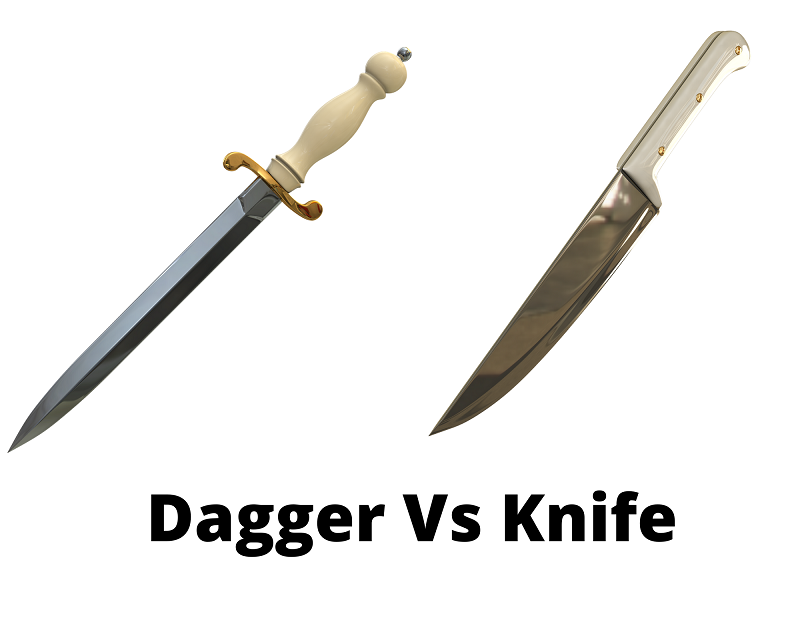
Daggers are double edged weapons, that are primarily stabbing weapons best designed for Impaling Damage. +1 Imp -1 Cutting. Sometimes the edges are not sharpened and instead they have a narrow, needle like point. Daggers are never folding weapons.

Push Daggers have a short blade and a t-shaped handle. When gripped, the blade protruded from between the fingers of the closed fist, and was used by punching at the target. Blade length is usually about 4 to 5 inches and they do 1d4 Impaling Damage only.

The Arkansas Toothpick, an American import but reminiscent of, and similar design to, many European short swords. It is a large, heavy dagger with a 12-to-20-inch (30 to 51 cm) pointed, straight blade, practically a short sword. The ‘Toothpick’ can be used for thrusting and slashing and are usually balanced for throwing. Toothpicks, and other daggers of this size, do 1d6 vs man sized opponents.
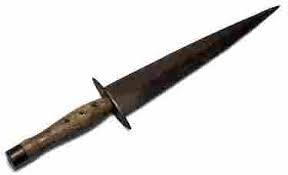
Knives are usually single edged, though a ‘clipped point’ may have an inch or two of sharpened edge on the back side of the blade. They do damage both impaling or cutting/slashing.
The “Bowie Knife” (an import from America) is a style of blade. A characteristic of Bowie knives is the clip point at the top of the blade, which brings the tip of the blade lower than the spine and in line with the handle for better control during thrusting attacks. As the goal is to produce a sharp, stabbing point, most Bowie knives have a bevel ground along the clip, typically 1/4 of the way, but sometimes much further running the entire top-edge. This is referred to as a false edge as from a distance it looks sharpened, although it may or may not be. Regardless of whether or not the false edge is sharp, it serves to take metal away from the point, streamlining the tip and thus enhancing the penetration capability of the blade during a stab. Large Bowie knives are heavy with a thick spine to aid in chopping. The blade lengths run from 9 to 12 inches. They do 1d4+2 damage either impaling or cutting/slashing. Smaller sized Bowies have blades of 6 to 9 inches and are a popular hunting knife with the false edge sharpened for skinning. They have no particular bonuses.
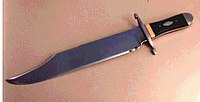
A Butcher Knife is not strictly speaking a weapon, though it can be used as such. It has a plain wood handle with no guard or bolster. They do 1d4 damage either impaling or cutting/slashing.
Pocket Knife or Pen Knife A small folding knife with a 2 to 4 inch blade. Purely a utilitarian ‘tool’ vs a weapon. They com in models with one, two, three or four blades of varying lengths, tips and functions. At best, the longer blades will do 1hp damage.

Knife, Hunting, Folding Clip-point blade, staghorn handle. When the blade is folded, it protrudes from the back of the handle, acting like a 4” fixed-blade knife. When opened, a folding cross-guard locks in place, and the blade length is 9 “. With leather sheath. This weapon will do 1d4 damage vs man sized opponents
Knife, Hunting The common sheath knife popular with hunters, trappers and many outdoors men. Useful for skinning, meat preparation and tasks around the campsite. They are also a functional weapon if needed. Usually single edged and having a blade about 6 inches in length. They come with a grips made from a variety of handles, leather, wood, stag horn, bone or rubber. They do 1d4 damage vs man sized opponent.

Knife, Sticking, 6” blade, plain wood handle without any guard or bolster. Blade is similar to a butcher knife, but with a more sharply pointed tip. It is used for slaughtering livestock (hence the expression “bleed like a stuck pig.”) This weapon will do 1d4 damage vs man sized opponents with a +1 for impaling damage only.
Automatic Knife One of several varieties of spring assist opening knives. Typically a single blades from 4 to 7 inches in length. They are designed to be opened with one hand. This weapon will do 1d3 damage vs man sized opponents
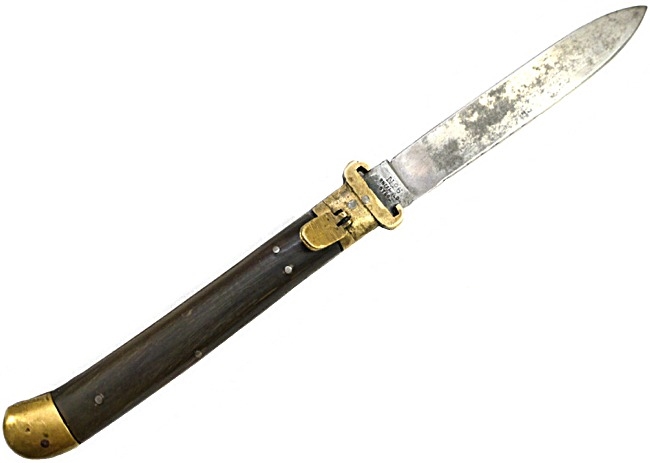
Throwing Knives. Although most knives can be thrown, these are designed and balanced specifically for throwing. Styles can vary from ‘dagger like’ to ‘knife like’ but they are generally a pointed, impaling weapon with little or no edged blade and little if any handle. The standard size has an overall length of about 7 inches and does 1-3 points. The larger size, 10 to 12 inches in length, do 1d4 damage. Either size is +1 to Hit when thrown.
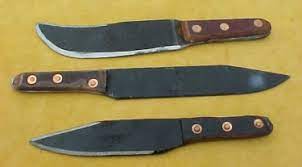
Bayonet, Regular. Bayonet blades and attachments have varied greatly by nationality, time period and rifle. The socket bayonet, while suitable as an ‘emergency’ knife, has no handle and is not what is considered here. The ‘Regular’ Bayonet refers to a bayonet that has a knife like handle or grip and a blade length of 8 to 12 inches. They are very stoutly made since they must with stand the leverage exerted by the length of the rifle being twisted and pulled to free it from an enemy. They are essentially a large, heavy, knife when used in hand, doing 1d4+2 damage for its added weight and thickness, versus a man sized opponent. When properly mounted on a rifle it does damage like a spear, 1d6 versus a man sized opponent See Sword Bayonet.
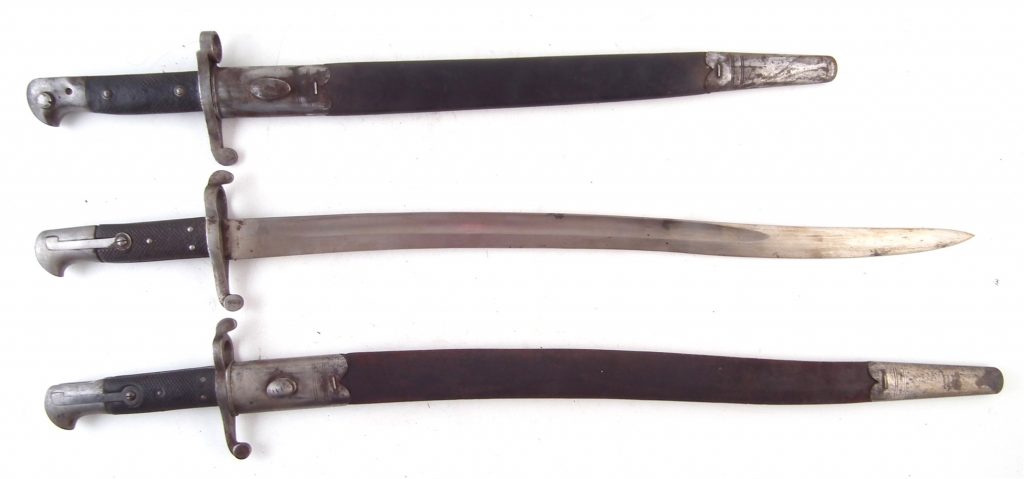
Kukri knife (Gurkha Knife)
The kukri is effective as a chopping and slashing weapon, due to its weight and because the curved shape creates a “wedge” effect which causes the blade to cut effectively and deeper. Because the blade bends towards the opponent, the user need not angle the wrist while executing a chopping motion. Unlike a straight-edged sword, the center of mass combined with the angle of the blade allow the kukri to slice as it chops. The edge slides across the target’s surface while the center of mass maintains momentum as the blade moves through the target’s cross-section. This gives the kukri a penetrative force disproportional to its length. The design enables the user to inflict deep wounds and to penetrate bone. +2 Cutting/Slashing Kukris come in a variety of lengths from Small (6 to 7 inch blade doing 1d3 Damage +2) Medium (10 to 12 inch blade doing 1d4 +2) Large (14 to 18 inch blade doing 1d6 +2) Very large (24 to 30 inch blade doing 1d8 +2) Kukri knives (of any length) are not commonly found for sale in England and are even less common in the US or the Continent. They ARE common in certain areas of India and if found for sale in England they are always used and the property of former Indian Army Officers or Soldiers, Civil Servants or travelers to India. Gurkhas, and their families, never sell their own weapons.
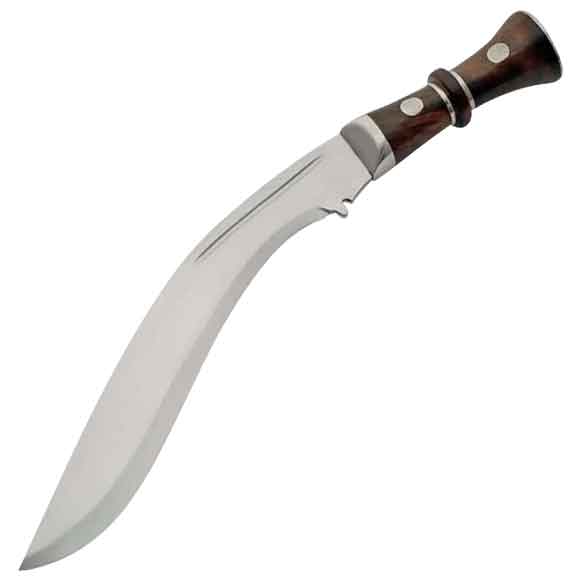
Cane or Corn Knife
Used in harvesting sugar cane and cutting corn stalks or similar crops. Not really a weapon, it has no hand guard and the blade is narrow, about an inch, generally with a rounded tip. They are generally kept very sharp and the blade is thin, and usually of cheap steel, so blows to, or parrying, another blade or against armor, stone, rifle barrel, etc have a good chance of breaking the knife. They are a one handed ‘weapon’ since it is intended that the other hand be gathering and holding the cane or stalk. Blade length is generally about 20 to 24 inches with a simple wooden grip drilled through for a wrist lanyard. These, or something similar, can be found on most farms. These are pretty much universally a cutting/slashing weapon with a thrust into a torso often resulting in a broken blade. It does 1d4+1 cutting damage
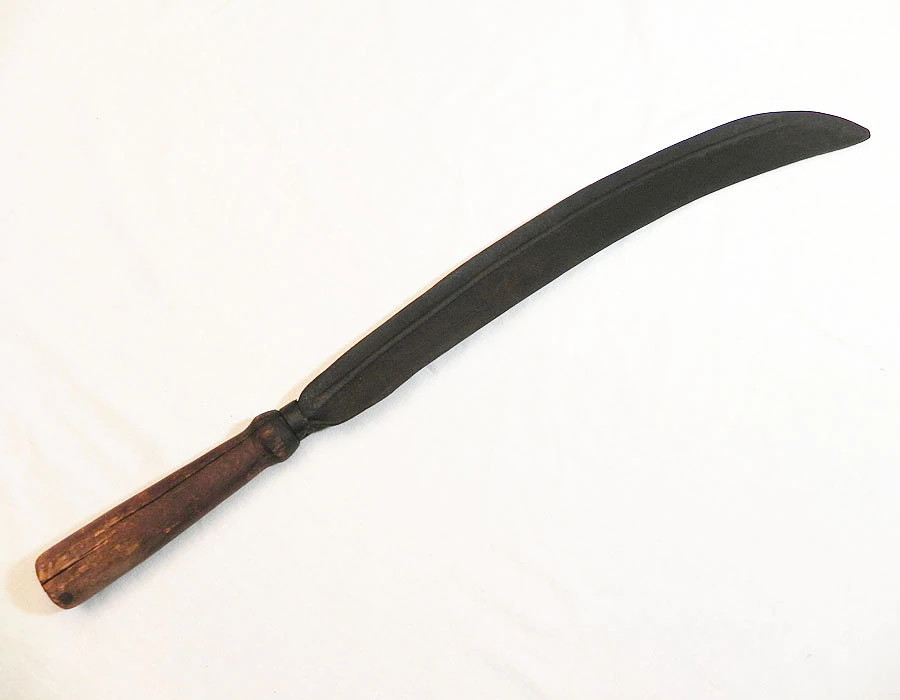
Swords
Artillery Sword
A common style of sword found in many continental armies and widely used in the United States during the Civil War and later. The design draws inspiration from the old Roman Gladius, being a short, straight, double edged blade with a simple cross guard, that was/is intended as a means of defense as well as a tool for entrenching, and working around the guns and their emplacements. Some officer blades are engraved with weights, measurements and various equations and tables of value in calculating angles and distance for the guns they served. The blade is typically 19″ long with a six inch hilt. In combat it is primarily a thrusting weapon, it does 1d6 damage (+1 Impaling damage) though it is capable of slashing/cutting attacks.
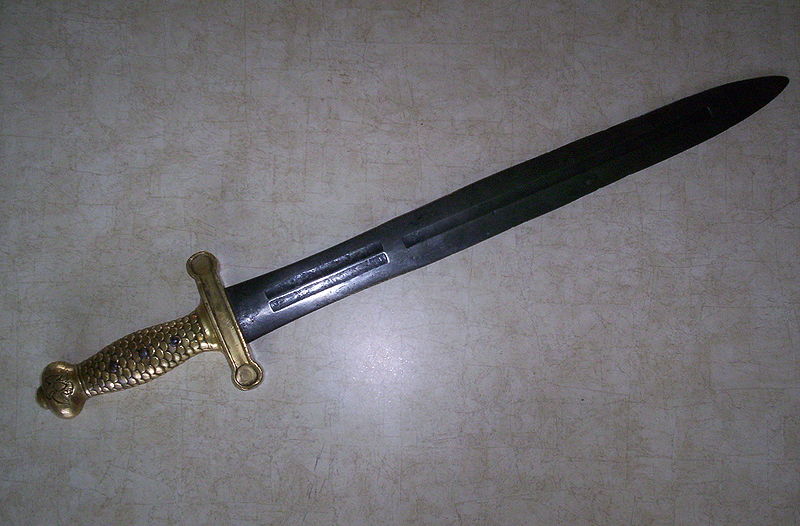
Hanger
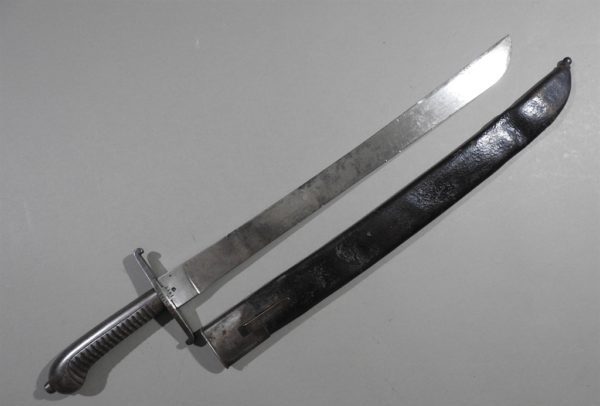
A short, straight, sturdy, single edged blade that was originally (and still primarily,) a hunter’s blade for dispatching large game and cutting through undergrowth. It has also been used as an Infantry weapon in various armies at various times. Though rarely used, Bobbies often carry Hangers under their coats. The tip is usually spade shaped and sharpened on both edges for easier killing thrust to the heart or jugular. It does 1d6 damage (+1 impaling damage) There is usually a simple loop guard for the hand, so it hangs flat against the body, and the blade length is about 18 to 19 inches with another six inches in the hilt.
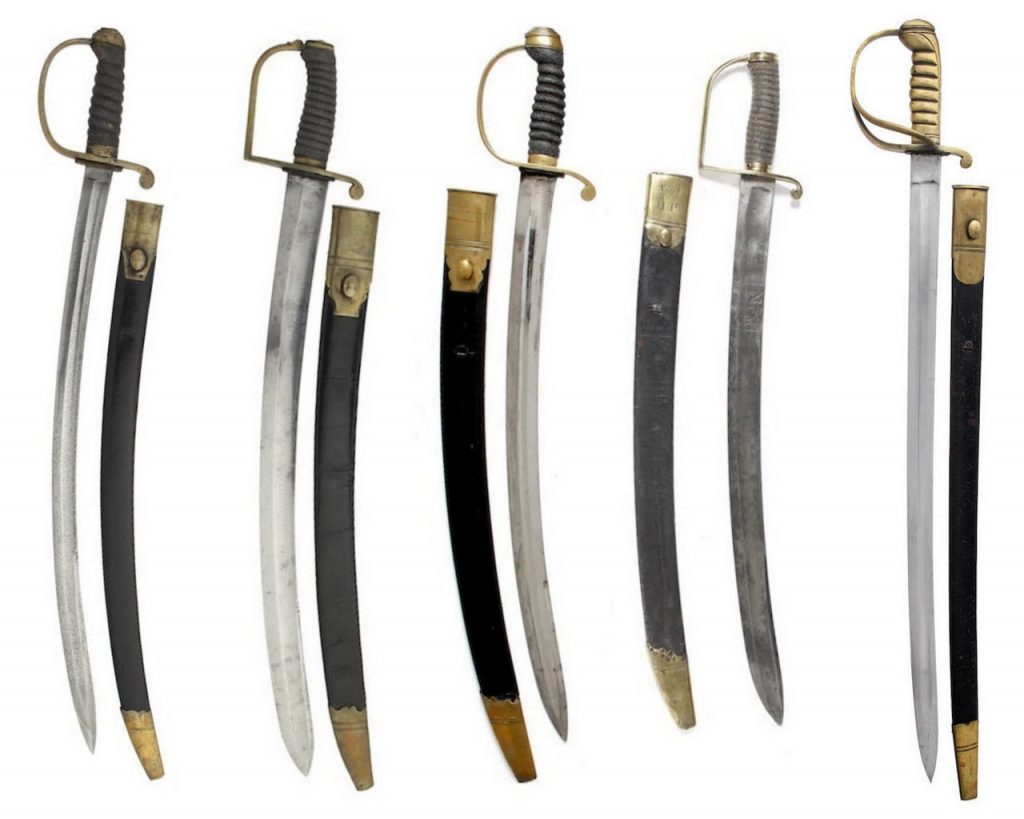
Machete
In contrast to the corn knife, the machete, which comes with a variety of blade shapes from saber point, rounded, hooked or squared off, has a thicker and wider blade. It too is primarily an agricultural tool and usually does not have much of a hand guard. But its more robust construction, intended to cut a wider range of vegetation, means that it can be an effective weapon. Many are made of cheap steel, so they are not as strong as most swords. The machete blade length is generally about 20 to 24 inches with a simple wooden grip drilled through for a wrist lanyard but the width of the blade is usually between two and three inches, often widening near the tip to give weight to the cut. It does 1d6 damage (+1 cut/slash) Machetes don’t lend themselves to stabbing or thrusting attacks (-1 imp.)
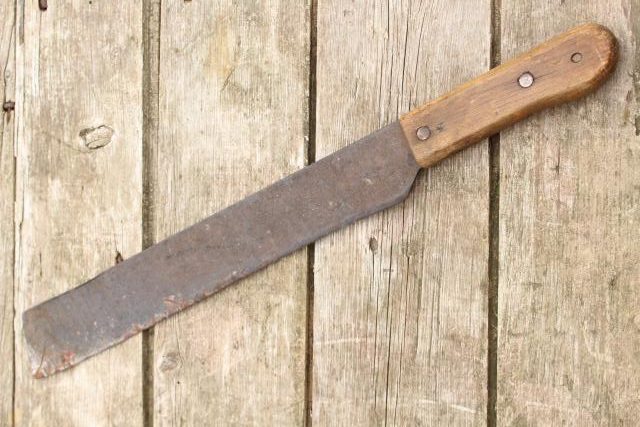
Claymore (Modern)
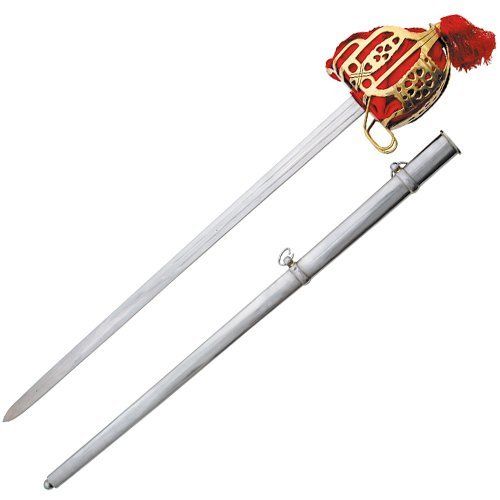
The 19th century Scottish sword is very different then the great, two handed swords of a few centuries earlier. The ‘modern’ Claymore is a one handed weapon, with a full basket hilt and a wide, straight, double edged blade that tapers slightly its entire length. It is probably the heaviest sword, and the closest thing to a traditional ‘Broadsword,’ that is still carried on the battlefield. Claymores are usually engraved and set with Clan markings and for anyone but a Scotsman (and a member of the appropriate Clan) to carry a Claymore will, at the very least, evoke comment and mild disapproval. The Claymore does 2d4 damage impaling and cutting/slashing vs man sized opponents. Note: Claymores MAY NOT be used as a fencing weapon.
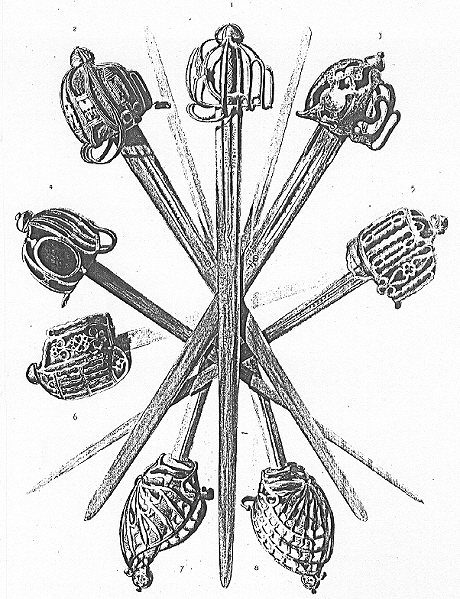
Rapier Style
The straight bladed ‘rapier’ type swords, commonly called ‘Spadroons,’ (sometimes called Spaldroons) were widely used, in varying blade widths and styles, by soldiers and officers going back to the 1650’s or earlier. The British military had begun shifting to saber style swords for officers beginning in the late 1700’s and completely by 1820’s. Though they are no longer made (except as special orders) they can still be found in many a shop, hanging on walls gathering dust or tucked in lumber rooms and closets. Carrying one in public is NOT fashionable or socially acceptable and it is not regulation for any officer.
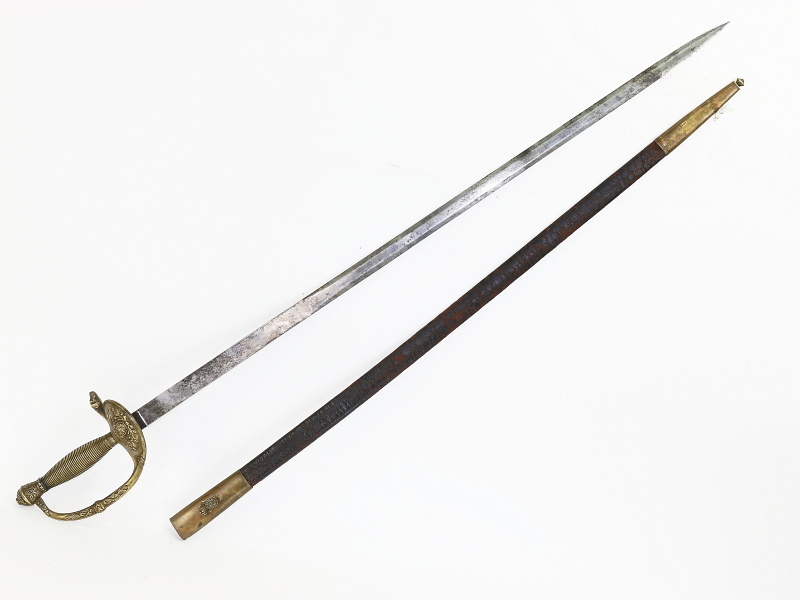
Some Continental Armies still use Rapier/Spadroon style swords for their officers, but sabers are largely replacing them. The Spadroon is a fencing weapon, employing the same style and techniques as the Small Sword. Spadroons and Rapiers do 1d8 damage vs man sized opponents.
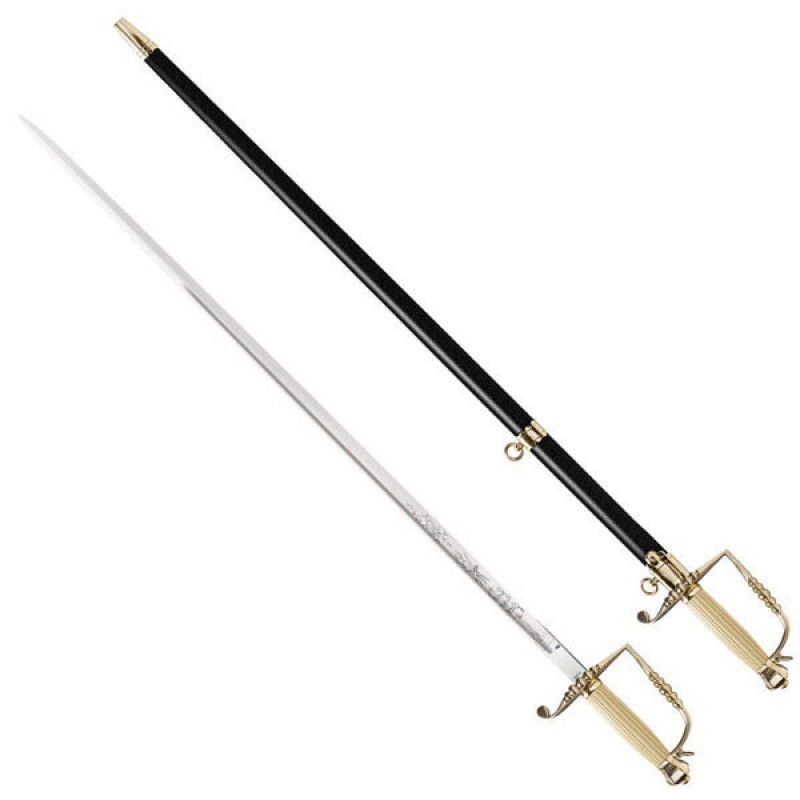
Sabers

There are a variety of saber styles in use in the 19th Century. Cavalry Sabers, Infantry Sabers, Artillery Sabers, Naval Sabers… With variations in Heavy Cavalry and Light Cavalry, French Infantry vs German, US and British… The various governments changing the patterns every few years, varying the length, the point, the degree of curve and so on. And since they don’t easily wear out, 18th century sabers and that era’s variations, are still found! For the most part these variations have no real impact on the weapon’s function and ability (with a few minor exceptions) and the choice is usually a reflection of the character’s background (Having been in the Infantry or the Navy. “My father was a Cavalry officer and I inherited this…” and so on.) With the exception of a couple of the heavier, wider blade, sabers, all sabers 1d8 vs man sized (Impaling and cutting) with the heavier versions gaining an additional +1 slashing/cutting damage. MOST sabers can be used as a fencing weapon (See Fencing.) There is far more variation in Hilts and Guards and the associated styles of the hilt and guard are often a reflection of the weapon’s use. Whether the saber is carried by a mounted man vs thumping against the hip of an infantry officer or mostly sitting in a rack on board ship…
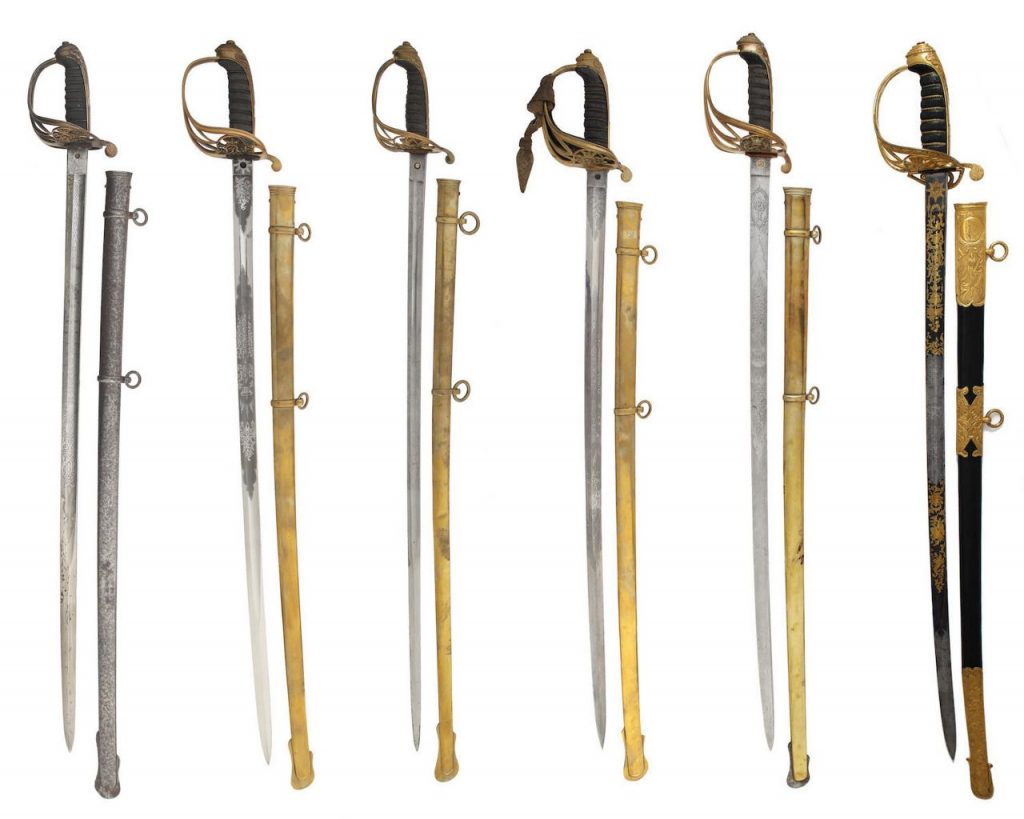
A special note on Mameluke style sabers. A Mameluke sword is a cross-hilted, curved, scimitar-like sword historically derived from sabers, (kiliji) used by Mamluk warriors of Mamluk Egypt after whom the sword is named. Although some genuine Ottoman sabers were used by Westerners, most “mameluke sabers” were manufactured in Europe or America; their hilts were very similar in form to the Ottoman prototype, but their blades tended to be longer, narrower and less curved than those of the true kilij, while being wider and also less curved than the Persian shamshir. In short, the hilt retained its original shape. but the blade tended to resemble the blade-form typical of contemporary Western military sabers. The style has become extremely popular, especially among senior officers and the Upper Class. In 1831 the “Mamaluke”, as the sword was now called, became a regulation pattern for British general officers.
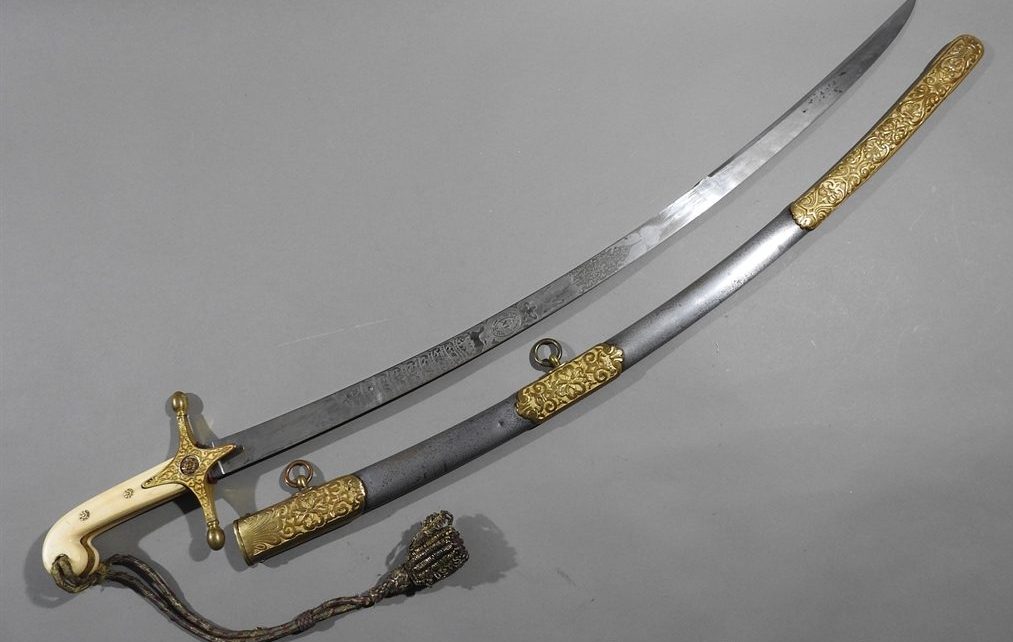
True kiliji and shamshirs ARE NOT suitable for fencing, but they do an extra +1 damage in cutting/slashing attacks.
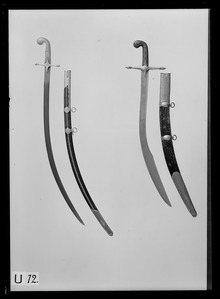
The shamshir is a curved sword, featuring a slim blade that has almost no taper until the very tip. Instead of being worn upright (hilt-high), it is worn horizontally, with the hilt and tip pointing up. It was normally used for slashing unarmored opponents either on foot or mounted; while the tip could be used for thrusting, the drastic curvature of blade made accuracy more difficult. (-2 to hit on Thrust/Impaling attacks) It has an offset pommel, and its two lengthy quillons form a simple crossguard.
Small Swords
These are thin, light, straight, always sharply pointed, sometimes single edged, some double edged some with no edge at all! They can be used as a fencing weapon. A small sword is primarily a Thrusting and Impaling weapon. It does 1d6+1 impaling or 1d4 slashing vs Man sized creatures.

Axes
Hatchet. A one handed, light utility axe that is widely used for splitting firewood into kindling, slaughtering chickens and similar tasks, It does cutting damage only, 1d6 versus man sized. A hatchet can be thrown, but it is not done easily and it takes considerable practice since they are not balanced for throwing. -1 to Hit when thrown.
Hatchet/Hammer. This is a one handed, multi function tool popular with carpenters. The blade side can be used as a hatchet for cutting attacks (see Hatchet) while the opposite face can be used as a hammer for crushing attacks, doing 1d4+1 vs man sized opponents. A hatchet/Hammer can be thrown, but it is not done easily and it takes considerable practice since they are not balanced for throwing. -1 to Hit when thrown.
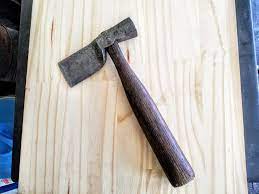
Hawk (Tomahawk) Modeled after the trade axes that were manufactured for sale and trade with the Native American Tribes. The Hawk has a longer handle then a utility hatchet or hatchet/hammer combo, though it is still a one handed weapon. This additional length increases the leverage and power of the blow. The back side of the blade often has a spade point or spike that does Impaling damage. Hawks do 1d6+1 cutting vs man sized opponents and 1d4+1 Impaling. The Hawk is also well balanced for throwing. +1 to hit.

Broad Axe. A one handed weapon with a larger head and longer handle then a hatchet. The wider blade is akin to the Bearded Axes of Medieval days. It is often used by woodsmen for trimming branches and de-limbing a felled tree and rough shaping a log, it is also a formidable weapon, doing 2d4 damage to a man sized opponent. It can be used with two hands, which adds +1 to damage. It is possible to throw a Broad Axe, but it requires a Strength of at least 13 and is -2 to hit.
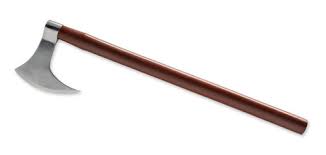
Boarding Axe A two handed version of a Broad Axe it is used aboard ship to cut away fallen rigging, spars and masts. As well as a weapon in ship to ship boarding actions, where in addition to being a fearsome weapon it is useful for splintering doors and hatches. The Boarding Axe requires two hands to use to full effect, though it can be used with one hand (treat it as a Broad Axe.) Two handed it does 1d10 damage vs man sized opponents. It is difficult to throw, and it must be thrown with two hands, and it requires a Strength of at least 13 and is -2 to hit
Woodsman’s Axe. This is the two handed axe most commonly used to fell trees and split firewood. The blade is narrower then a Broad Axe, but it is also thicker, more wedge shaped, allowing the weight and strength of the blow to split wood and gouge out chips from the tree trunk. Though not well balanced for fighting, or throwing, it can be an effective weapon. It does 1d8 to man sized opponents. It is possible to throw a Woodsman’s Axe, but it requires a Strength of at least 13 and is -2 to hit.
Baseball Bat. An American import that has limited popularity in Victorian England. (Obtaining a baseball bat in the UK will not be easy. Explaining it to the constable even less so.) Hardwood, usually Hickory, baseball bats are very effective weapons. They are well balanced and very strong. Baseball bats in 1890 were not standardized. Many players whittled their own! Weight will vary from 2 to 3 pounds and length from 30 inches to as much as 48 inches. From a combat view point the difference in insignificant. Damage to a man sized opponent is 1d6 crushing. Being made from a single piece of hardwood, unless the opponent is armored, there is no chance that a baseball bat will be damaged in a fight. Against someone using a shield or plate type armor, the chance is 10%.
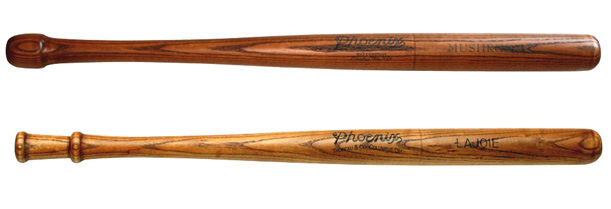
Billy Club or Truncheon. This is the primary weapon of the British Police Constable, or ‘Bobby.’ The late Victorian police truncheon was only fifteen inches in length and lived in a specially-built pocket of the officer’s trousers. The actual Scotland Yard issue Truncheon is made of Lance and Crocus wood. A truncheon is not meant to kill, the woods used are not hardwoods like ash, oak or similar. Instead it is a resiliant wood that resists breakage, also ‘gives’ a bit to deliver a blow that while painful, is not likely to prove fatal. Against a man sized opponent a Truncheon does 1d4+1 crushing damage. Bobbies are trained to pull their blows, so MOST OF THE TIME damage in non-lethal, meaning that only 50% is real and though the target may be knocked out when hit points equal zero, half of those will return in an hour or two.
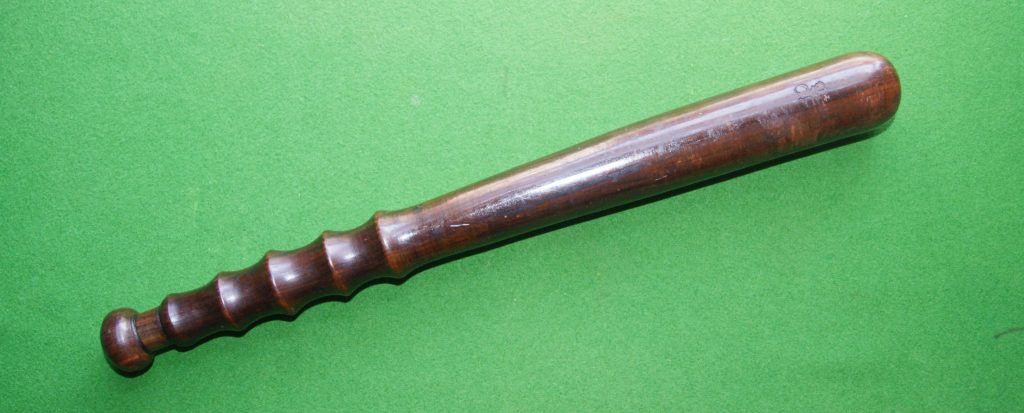
Life-Preserver. A variant of the club was the so-called life preserver. Easily hidden at about a foot in length, it had a flexible shaft of whalebone or some such supple core, leather-wrapped, with a weighted knob at one end or both ends. Principal targets were the head and wrist. They were sold as defensive weapons, but were often used as offensive weapons. A Life Preserver will do 1D4+1 damage vs a man sized opponent. Damage is (usually) non-lethal

Cricket Bat. Though an unlikely weapon, it is still a potential weapon. Cricket Bats are traditionally made from willow wood, specifically from a variety of white willow called cricket bat willow treated with raw (unboiled) linseed oil, which has a protective function. This variety of willow is used as it is very tough and shock-resistant, not being significantly dented nor splintering on the impact of a cricket ball at high speed, while also being light in weight. The blade of a cricket bat is a wooden block that is generally flat on the striking face and with a ridge on the reverse (back) which concentrates wood in the middle where the ball is generally hit. the Laws of Cricket state that the length of the bat may be no more than 38 inches, though very few exceed 35 inches. The width no more than 4.25 inches, the overall depth no more than 2.64 inches and the edge no more than 1.56 inches. Bats typically weigh from 2 lb 7 oz to 3 lbs. The cane shaped handle is spliced to the blade. Using a cricket bat as a weapon will quickly damage the bat (they really are not designed for this!) But until it breaks it will do 1d4+1 crushing damage to a man sized target. There is a 10% chance (cumulative) per blow of the handle breaking.

Loaded Hunting Crop. A variation of the life-preserver, (much favored by Sherlock Holmes.) To outward appearances a normal wood and leather crop, the loaded hunting crop contains a steel or lead core wrapped in leather. They range from 18 to 24 inches in length. They are not easily concealed, bt can be tucked in one’s belt or allowed to hang from the wrist by a leather loop. They are employed much as a life-preserver or truncheon. The crop will do 1D4+1 damage vs a man sized opponent. Damage is (usually) non-lethal.

Knuckleduster. Or, as commonly known in America, ‘Brass Knuckles.’ This has the advantage of being readier to hand than a pocketed cudgel, since in seamier districts it could remain on the fist. It is used in conjunction with Boxing, Brawling or Enhanced Brawling. (NOTE: Using a knuckleduster in a boxing bout, formal or informal, is VERY unsportsmanlike!) While a normal punch does 1-2 points of non-lethal damage (plus Strength bonuses) The knuckleduster will cause 1d3 points of REAL damage against a man sized opponent. A character’s Strength bonus, if any, does apply.
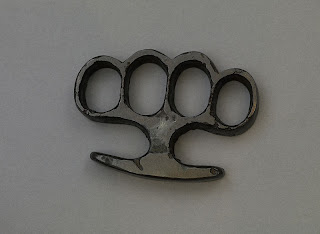
Apache Ring. Essentially a knuckleduster for one finger but operating in the same manner. Named for the vicious French street gangs of the Belle Époque who favored them, they have fearsome projections that would leave ghastly wounds on the faces of their victims to serve as warnings against future trespass. Apache rings are designed to hurt, scar and frighten, not to kill. They add 1pt of real damage to a normal punch of 1-2 non-lethal plus strength bonuses. Each blow with the ring has a 1 in 3 chance of cutting the target’s face with a 50% chance that the resulting wound will leave a disfiguring scar that will reduce appearance (Comeliness) by 1-2 points per scar.
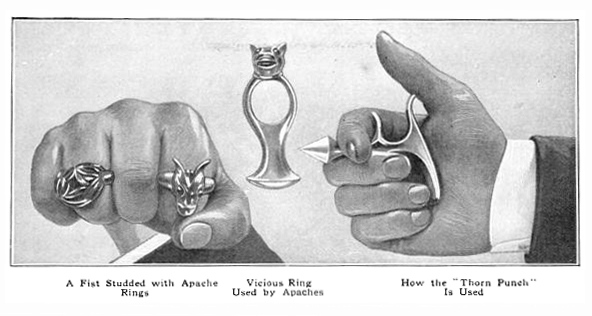
Walking Stick There is an amazing variety of shapes, sizes, materials, and gadgetry to be found in walking sticks. A stick is considered to be ‘essential equipment’ for a man or woman of means. These can range from plain and simple to gilded and ornate, essentially functional jewelry, that will be decorated to the level of the bearer’s wealth in a very status-conscious age. That they can assist the lame, infirm or inebriated to walk is a side benefit!
Some canes are purely utilitarian, like a good Irish Blackthorn, for those that have no time to waste on mere foppery. With the added benefit that such a stick makes serviceable weapon and is less of a loss if it is shattered across the head of a thug.
Using a walking stick in combat is a technique referred to as ‘Single Stick.’ It is closely related to swordsmanship and fencing, but since there is no blade it has a different form. (Anyone with Swordsmanship or Fencing, may employ a walking stick as a weapon at no minuses to hit. Someone trained in Singlestick may utilize a sword at -1 to hit.)
A light weight walking stick, like bamboo, is not much more then an ornament (unless it is concealing something.) It is suitable for beating off pesky urchins, but will at best fluster a real footpad, doing little more then sting in terms of real damage.
For self-defense a heavy knobbed stick that can cave in the skull of a determined adversary is recommended. If it is weighted, as is often the case, it becomes a much more formidable weapon. A weighted Stick is one where a portion is hollowed out and filled with a steel bar or lead, adds considerably to a stick’s effectiveness.
Malacca canes, though light in weight, are very strong. Blackthorn, or the traditional ‘Shillelagh’ is a strong walking stick and a formidable weapon even when it it not weighted. Other suitable medium weight woods include Ash, Hickory, Walnut and most other hardwoods. Oak makes a good, stout, stick in itself, suitable for laying about a ruffian’s head and shoulders.
Heavy, dense, hardwoods, like Ironwood, Ebony, Mahogany and Teak, make a strong, (though expensive) and heavy, walking stick which in itself makes as much of an impression as a weighted medium stick, and if these woods are weighted you have a weapon that is as close to a footman’s mace as you are going to get and still be fashionable. These woods are difficult to work with so they are not used for elaborate System Sticks.
Although there are no visual clues to allow a weighted stick to be identified, it is immediately obvious when the stick is handled. A skilled police officer, or someone trained in Single Stick, may recognize a weighted stick from the way it is carried, it having a different heft and balance from a ‘normal’ stick.
System Sticks So called because they contained any number of clever devices, from brandy flasks, telescopes, compasses to complete medical kits. Simplest was the classic sword stick, a steel blade inside the hollow shaft. An advantage of a sword stick was that once drawn the user had a pair of weapons, for the hollow body made a splendid cudgel/parrying stick in its own right.

Hidden blades are very popular in walking sticks, umbrellas and parasols. Blade lengths are usually either dagger like, 6 to 10 inches, single or double edged with some having no sharp edges but are instead a stiletto like ‘needle.’ Or, they are sword length, 18 to 24 inches and are considered a ‘Small Sword’ for combat purposes. Like the dagger blades they can be single or double edged and some are purely thrusting weapons.

The short dagger blades can be built into the handle and shaft of any wood type, oak or the heavy woods, allowing for the shaft, without the handle, to continue functioning as a useful weapon. The sword blades are almost always in a bamboo or other light weight (easily worked) wood. The ‘sheath’ can be used as a light stick, though it will do little damage. Sticks with concealed blades are not Weighted for striking purposes. The removable handle and the hollow space for the blade, makes the stick too weak, with or without the handle, for repeated strikes. A well crafted handle can make it impossible to recognize the presence of a concealed blade from mere visual observation.
A few expensive System Stick varieties have spring-loaded stiletto points that can pop out of the end allowing one to stab at an attacker, much like a small sword.
Quite a few canes are specially crafted firearms. But turning one’s stick into a shotgun should be considered a step backward for the genteel man.
Gun Canes Although uncommon and expensive, gun canes are produced. Calibers vary from .22 up to .45, with a .410 shot shell as a possible variant. They come in two basic styles. In the first type, the handle is attached to a short barrel, usually 2 to 5 inches, creating a short barreled, single shot pistol with an awkward grip and a folding, concealed, trigger. The ‘gun’ is drawn from the cane shaft, much like a dagger, pointed at the target and fired.
The second type, has the gun barrel built into and running the length of the stick. The owner points the entire stick at the target, manipulating the cocking mechanism and exposing the trigger, and then fires a very long barreled pistol! Holding the cane in an extended ‘pistol’ fashion is rather awkward (-2 to hit) and they are generally held at waist level or at the hip, with the other hand steadying the barrel (-1 to hit any target more then fifteen feet away.) Whacking someone with a gun cane, particularly the full length barrel varieties, is not recommended. Though it will do damage equal to a weighted walking stick, the likelihood of irretrievably bending the barrel is high.

Both guns are single shot weapons that require some disassembly to reload. The short barreled pistol versions often store an extra cartridge in the removable ferrule on the foot of the cane. The long barrel cane guns have a thin piece of cloth fitted over the muzzle to keep dirt out. The user must take care to not lean to heavily on this type of cane, or thrust it into soft earth, mud, icy slush, snow etc. If the muzzle is obstructed the cane gun will explode.
Both types of gun cane have visible features in the handle, specifically a hammer that cocks the weapon and extends the fold away trigger OR a twist mechanism that cocks the weapon and extends the fold away trigger. A knowledgeable observer will (50% of the time) recognize the gun cane for what it is.

NOTE: Reloading either of these guns (both are single shot) is somewhat more involved then reloading a single shot pistol. The efforts made to render the weapon sleek, compact and unobtrusive, requires more effort (and time) on the part of the owner to reload.
Umbrella and Parasol Ladies are not forgotten either. Though a lady’s walking stick, or cane, is most often seen carried by a lady who is elderly or one who is infirm, it does not preclude their use by any woman. Additionally, a lady often carries a parasol or ‘umbrella’ which may also have reinforced shafts that allow a woman to fend off unwanted attention. The shaft of these reinforced parasols or umbrellas is the equivalent of a Medium weight walking stick. An ordinary umbrella is about the same as a light walking stick. The folded fabric does reduce the damage somewhat, but this is made up for with the pointy end and the multi purpose functionality of the device. (Men can also avail themselves of an umbrella version of the medium walking stick.) Many books and Athletic Clubs exist to teach a young lady tactics to be employed with an umbrella.
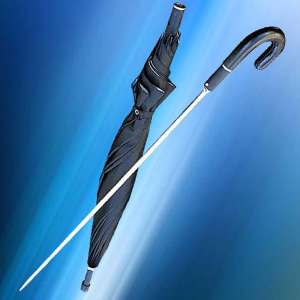
It is also possible to have the shaft of an umbrella or parasol conceal a hidden weapon. Bamboo, Ash or Malacca are the most common materials used. Heavier woods like Ebony, Teak and Mahogany, are not commonly used in umbrella and parasols, and the shaft or stick is not weighted so as to not interfere with the umbrella’s more prosaic function.

Hatpin While ladies’ fashions have varied widely, from enormous hoop skirts to bustles to leg-of-mutton sleeves, hatpins are a constant. Particularly when bonnets tied under the chin gave way to hats perched atop the head, and even more so with the advent of wide-brimmed affairs easily caught by the wind, hatpins are utterly essential items for all women. So large is the demand that one Gloucestershire factory employs over 1,500 workers.
Pins vary with purpose, but in general they have grown to be very long, some over 14 inches, to accommodate the increasing size of hairstyles and chapeaus. Legislation has to be enacted to limit both the length of pins and the danger of their exposed points, requiring caps on the later so as to not scratch passersby. It takes no great imagination, of course, to envision pins as weapons. A shorter (up to 8”) sturdy hat pin will do 1-2 Hit Points impaling damage, while the longer versions can do 1d4 impaling, versus man sized opponents.
